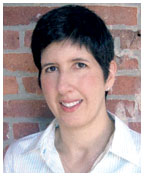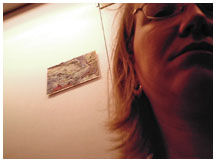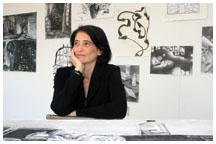December 13, 2006: Books and Arts
Reading Room
The case against homework
Nancy Kalish ’82 argues that busywork is damaging kids
For a complete list of books received, click here.
Nancy Kalish ’82 offers parents advice on how to stem homework overload. (Crown) |
Reading
Room
The
case against homework
Nancy Kalish ’82 argues that busywork is damaging kids
Nancy Kalish ’82 used to be a big believer in homework. As a freelance writer for parenting magazines, Kalish even advised parents how to get their kids to do it.
But her resolve changed when her daughter entered seventh grade and began drowning in four hours of homework a night at her private school in Brooklyn, N.Y. Her daughter “just couldn’t face” the mounds of work, says Kalish. “I panicked,” she says, and she pushed her daughter to do the assignments. As a result of homework overload, her daughter began eating dinner at her desk, skipping family social activities, and dropping out of extracurricular activities.
The worst part for Kalish, she says, was that her daughter “started to say she hated school every day.”
Kalish found that other families at the school were similarly distressed. Another mother, Sara Bennett, began organizing parents to convince administrators to rethink the school’s homework policy. While they were fighting for their kids’ sanity, Kalish and Bennett, a lawyer, decided to write a book, The Case Against Homework: How Homework Is Hurting Our Children and What We Can Do About It.
 Published
by Crown in September, The Case Against Homework synthesizes
research on homework, surveys and interviews with parents and teachers
in public and private schools, and advice for parents on how to end homework
hell. To Kalish’s surprise, she found that there is “very
little correlation” between homework in elementary school and academic
achievement and only a “moderate correlation” in middle school.
Published
by Crown in September, The Case Against Homework synthesizes
research on homework, surveys and interviews with parents and teachers
in public and private schools, and advice for parents on how to end homework
hell. To Kalish’s surprise, she found that there is “very
little correlation” between homework in elementary school and academic
achievement and only a “moderate correlation” in middle school.
Kalish, an English major at Princeton, and Bennett argue that homework overload is eating up family time and causing children to become more stressed and sedentary because they do not have enough time to exercise, socialize, and get a break from schoolwork.
A homework expert quoted in the book, Harris Cooper of Duke Univer-sity, suggests that each night students should get no more than 10 minutes of homework per grade starting in first grade, up to a maximum of two hours in high school. Beyond that point, according to Cooper, the benefits of homework decline rapidly, because the children are not able to focus and learn for longer periods of time.
The authors outline what parents can do to stem excessive homework. They could write a note telling the teacher that they don’t see the educational value in having a child create a replica of the Pentagon out of popsicle sticks or doing 50 math problems instead of just five. Most times, says Kalish, teachers will be receptive and concerned that their assignments are causing a child distress. If the teacher is unresponsive, parents might consider organizing to try to change their school’s homework policy.
Bennett and Kalish were able to get their children’s school to eliminate vacation homework, limit weekend homework, and make teachers accountable for the kind of homework assigned, among other changes. But by that time, Kalish already had switched her daughter to another school.
Today, her daughter loves learning again. A tenth-grader, she has two
hours of homework a night — still a lot, but the quality is better.
Says Kalish, “We are back to having a lovely, mostly positive relationship.”
![]()
By K.F.G.
For a complete list of books received, click here.
 A
Visitor’s Guide to Colonial and Revolutionary New England
— Patricia and Robert Foulke ’52 (Countryman Press). This
guide is geared for travelers who want not only to find good places to
lodge and interesting sites to explore, but also to learn the history
behind the places they visit. The book covers Massachusetts, Connecti-cut,
Rhode Island, New Hampshire, Maine, and Vermont. The authors have written
13 other travel guides.
A
Visitor’s Guide to Colonial and Revolutionary New England
— Patricia and Robert Foulke ’52 (Countryman Press). This
guide is geared for travelers who want not only to find good places to
lodge and interesting sites to explore, but also to learn the history
behind the places they visit. The book covers Massachusetts, Connecti-cut,
Rhode Island, New Hampshire, Maine, and Vermont. The authors have written
13 other travel guides.
 Squirrels: The Animal Answer Guide — Richard W. Thorington
Jr. ’59 and Katie Ferrell (Johns Hopkins University). In a question-and-answer
format, the authors share information about squirrels, including what
they eat, whether they make good pets, how they reproduce, and whether
they carry human diseases. Thorington is a curator of mammals at the Smithsonian’s
National Museum of Natural History. Ferrell was his research assistant.
Squirrels: The Animal Answer Guide — Richard W. Thorington
Jr. ’59 and Katie Ferrell (Johns Hopkins University). In a question-and-answer
format, the authors share information about squirrels, including what
they eat, whether they make good pets, how they reproduce, and whether
they carry human diseases. Thorington is a curator of mammals at the Smithsonian’s
National Museum of Natural History. Ferrell was his research assistant.
 The Notebooks of Robert Frost — edited by Robert Faggen
’82 (Harvard University). Faggen has transcribed and edited about
50 notebooks belonging to the poet Robert Frost from the late 1890s to
the early 1960s. In the notebooks, which have never before been published,
Frost recorded his thoughts on topics ranging from poetics and politics
to religion and science. Faggen is a literature professor at Claremont
McKenna College in Claremont, Calif.
The Notebooks of Robert Frost — edited by Robert Faggen
’82 (Harvard University). Faggen has transcribed and edited about
50 notebooks belonging to the poet Robert Frost from the late 1890s to
the early 1960s. In the notebooks, which have never before been published,
Frost recorded his thoughts on topics ranging from poetics and politics
to religion and science. Faggen is a literature professor at Claremont
McKenna College in Claremont, Calif. ![]()
By K.F.G.
For a complete list of books received, click here.
(Photo courtesy Lori Hayes ’95) |
Lori Hayes ’95, pictured with a painting in a subway car in New
York City, decided she wouldn’t wait for a solo show. Instead, Hayes,
who earned a master’s of fine arts from Burren College of Art in
Ireland last year, created her own exhibit by installing her artwork in
the city’s subway cars. Since last summer, she has hung about 100
4-by-6-inch sections she had cut out of a larger painting. Hayes, whose
abstract paintings evoke landscapes and focus on capturing moments in
time, hopes that strangers will take the art home. Says Hayes, “I
like the idea of cutting up a monumental painting ... dispersing it within
a public space ... and seeing what might happen.” ![]()
Eve Aschheim’s next exhibit is in February at New York’s Lori Bookstein Gallery. (Denise Applewite/Office of Communications) |
The
artist-teacher challenges her students — and herself
Eve Aschheim pushes her students to draw the impossible
By Van Wallach ’80
By day, Eve Aschheim teaches drawing and painting at Princeton. She taps her students’ imaginations with exercises in which, she says, “you draw things that are impossible to draw,” such as motion.
By night, she is back in her studio on New York’s West Street, on the edge of the Hudson River. There, she challenges her own imagination as she adds to an impressive body of art that can be found in the collections of the Museum of Modern Art in New York and the National Gallery of Art in Washington, D.C., among others. Her next show comes in February, when 18 pieces — drawings on paper about a foot square, spare patterns of lines and dots that give a sense of space and movement — will be displayed at New York’s Lori Bookstein Gallery.
Aschheim moves easily between the academic and art worlds. After studying and teaching in California, Aschheim first taught at Princeton in 1991, and became director of the visual arts program in 2003. Teaching at Princeton “makes me articulate how the internal structures of art function, which helps my own art,” Aschheim said one evening as she bustled around her studio, evaluating works in progress for the Bookstein show. Living and working in New York connects her to an art scene “where there is so much energy that it keeps you up working at night.” She takes that energy back to her students to keep them connected to emerging art.
Aschheim’s recent drawings mark an evolution from her earlier works. A decade or so ago, drawings with titles like X Drop and Filibuster had dense patterns of lines, both parallel and crossing. Some works suggested schematics or blueprints, reflecting Aschheim’s early academic interest in architecture. More recent works, such as Marcel’s Paint, lack the “substructure” of lines that create quickly recognizable forms. Instead, she’s taking a “less is more” approach where the lines imply shapes and space.
As Aschheim’s art evolves, so does her teaching style. She says a more “open” approach lets students use their imaginations, once they know how to work with basic elements such as lines, shading, and composition. “After that, I push them to do something they’re not familiar with.”
One of her favorite exercises is to have students draw the way their brains work. She asks them to draw memory, brainstorming, or emotions. “How do all these systems work?” she muses. “It makes you think about how you represent something that’s never been drawn before — how do students capture their own thinking?”
The results: One student drew a bureau with drawers of different sizes
— some partially open and neatly arranged, others messy, and still
others closed. Another student made an abstract drawing with the word
“ruminate” written at the bottom and a long arrow pointing
up. Above the word were amorphous chambers and rectangles into which the
thoughts might float. “The drawings are radically different,”
says Aschheim. “I get an amazing array.” ![]()
Van Wallach ’80 is a freelance writer in Stamford, Conn.



